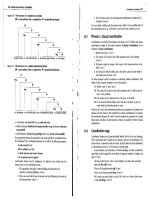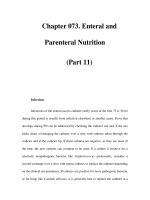lubricants and hydraulic fluids Episode 11 ppsx
Bạn đang xem bản rút gọn của tài liệu. Xem và tải ngay bản đầy đủ của tài liệu tại đây (26.53 KB, 7 trang )
EM 1110-2-1424
31 Jul 06
Change 1
C-
3
SPECIFICATION FOR TURBINE OIL
TURBINE OIL
TABLE OF CONTENTS
1. GENERAL
2. REFERENCES
3. SUBMITTALS
4. TURBINE OIL CHARACTERISTICS AND REQUIREMENTS
5. TESTING
6. PRE-DELIVERY TESTING
7. DELIVERY
8 . INSPECTION AND ACCEPTANCE.
1. GENERAL
This specification covers zinc and chlorine-free rust and oxidation inhibited (R&O) mineral oils for use in
hydraulic turbine and generator bearings, Kaplan turbine hubs, hydraulic-turbine governors, and other
applications, where high-grade lubricating oil having anti-corrosion, anti-oxidation, and anti-foaming
properties is required.
2. REFERENCES
The publications listed below form a part of this specification to the extent referenced. The publications
are referred to in the text by basic designation only.
AMERICAN SOCIETY FOR TESTING AND MATERIALS (ASTM)
ASTM D 92 (2002b) Flash and Fire Points by Cleveland Open Cup
ASTM D 97 (2004) Pour Point of Petroleum Oils
ASTM D 130 (2004) Corrosiveness to Copper from Petroleum
Products by Copper Strip Test
ASTM D 445 (2004e1) Kinematic Viscosity of Transparent and
Opaque Liquids (and the Calibration of Dynamic
Viscosity)
ASTM D 664 (2004e1) Acid Number of Petroleum Products by
Potentiometric Titration
ASTM D 665 (2003) Rust-Preventing Characteristics of Inhibited
Mineral Oil in the Presence of Water
ASTM D 892 (2003) Foaming Characteristics of Lubricating Oils
EM 1110-2-1424
31 Jul 06
Change 1
C-4
ASTM D 943 (2004a) Oxidation Characteristics of Inhibited Mineral
Oils
ASTM D 1401 (2002) Water Separability of Petroleum Oils and
Synthetic Fluids
ASTM D 2270 (2004) Calculating Viscosity Index from Kinematic
Viscosity at 40 and 100 Degrees C
ASTM D 2272 (2002) Oxidation Stability of Steam Turbine Oils by
Rotating Pressure Vessel Oxidation Test
ASTM D 3427 (2003) Air Release Properties of Petroleum Oils
ASTM D 4057 (2000) Manual Sampling of Petroleum and Petroleum
Products
ASTM D 4177 (2000) Automatic Sampling of Petroleum and
Petroleum Products)
ASTM D 6304 (2004ae1) Water in Petroleum Products, Lubricating
Oils, and Additives by Coulometric Karl Fisher
Titration
INTERNATIONAL ORGANIZATION FOR STANDARDIZATION (ISO)
ISO 4406 (1999) Coding the Level of Contamination by Solid
Particles
ISO 11171 (1999) Calibration of Automatic Particle Counters for
Liquids
3. SUBMITTALS
Government approval is required for submittals with a "G" designation; submittals not having a “G”
designation are for information only. When used, a designation following the “G” designation identifies
the office that will review the submittal for the Government. The following shall be submitted:
3.1. DATA
Data of Chemical and Physical Characteristics of Turbine Lubricating Oil, G [, _____ ]
The Contractor shall furnish [ _____ ] copies of certified test data, which show that the oil meets or
exceeds characteristics values specified in TABLE 2. The certified test data shall be submitted for
approval 30 days before the oil delivery.
3.2. SAMPLES
A gallon of proposed turbine oil, G [, _____ ]
EM 1110-2-1424
31 Jul 06
Change 1
C-
5
The prospective bidder shall send one gallon of oil to the Government along with the bid. This oil shall
be closely representative to the oil being offered in the bid. The Government plans to send a quart of this
oil in an unmarked container to an independent laboratory for compatibility testing with the in-service oil.
The compatibility testing will be performed at no charge to the prospective bidder. If the submitted oil
sample is found to be incompatible with the in-service oil, this oil will not be further considered in the
Contract awarding process.
4. TURBINE OIL CHARACTERISTICS AND REQUIREMENTS
4.1 GENERAL PROPERTIES
The turbine oil should be a blend of virgin petroleum-based stocks plus additives, free of zinc and
chlorine, resulting in a high-grade turbine oil having anti-rust, anti-oxidation and anti-foaming properties
suitable for use in hydraulic turbines, generator bearings, Kaplan turbine hubs and related applications.
4.2 VISCOSITY
The oil viscosity should fall within the range as specified in TABLE 2.
4.3 CHEMICAL AND PHYSICAL CHARACTERISTICS
The turbine oil shall conform to the requirements established in TABLE 2 when tested according to the
standards indicated there.
4.4 DEGRADATION
The physical and chemical properties of the oil shall not be degraded (changed from specified values in
TABLE 2) by filtration through two-micron mechanical type filters, by centrifugal purification, or by
vacuum type purifier, all of which have been designed for turbine oil.
4.5 HOMOGENEITY
Additive agents shall remain uniformly distributed throughout the oil at all temperatures above the pour
point and up to 120 ºC (250 ºF). When the oil is cooled below the pour point, it shall regain homogeneity
while standing at temperatures of 5 ºC (10 ºF) above the pour point, and retain clear and bright
appearance.
4.6 COMPATIBILITY
Before the oil is being purchased for addition to existing (in-service) oil or as replacement oil, the
Government will perform an independent compatibility testing of the two oils (new and in-service oil).
The testing shall be performed in accordance with paragraph COMPATIBILITY TESTING and evaluated
in accordance with paragraph APPEARANCE RATING PROCEDURE. If wish to conduct the test,
potential suppliers shall contact the Contracting Officer to obtain a representative sample of the in-service
oil required. The paragraphs COMPATIBILITY, COMPATIBILITY TESTING, and APPEARANCE
RATING PROCEDURE are not applicable for new construction.
5. TESTING
5.1 COMPATIBILITY TESTING
EM 1110-2-1424
31 Jul 06
Change 1
C-6
The following testing procedure shall be used for evaluation of compatibility between new and in-service
oils (for convenience, new oils are called “A” oils, and in-service oils are called “B” oils):
a. Prepare separately 300 ml of each mixture of the following ratios: 90:10, 50:50, and 10:90 of the
two oils (A and B) to be evaluated for compatibility. The two constituent oils (100:0, and 0:100)
shall be tested concurrently.
b. Stir each mixture vigorously in a laboratory glass mixer (minimum volume capacity of one quart)
for 30 minutes, and immediately transfer to a glass beaker of suitable size for each mixture. Use
a suitable rubber spatula, and squeegee the remaining oil into the glass beaker.
c. Heat the beakers with the mixtures in the oven at 65 ºC (150 ºF) for 168 hours (± 1 hour).
d. Remove the beakers from the oven and allow to cool to room temperature.
e. Observe the oil samples according to the procedure described in paragraph 5.2, Appearance
Rating Procedure. If any of the oil mixtures tested display an incompatible result, conclude the
test and report that the new oil is not acceptable for use. If the results are satisfactory, proceed to
the next section.
f. Cool the beakers with the oil mixtures to 0 ºC (32 ºF) and keep them at this temperature for 24
hours.
g. Remove beakers from the cooler and bring to room temperature.
h. Observe the oil samples according to the procedure described in paragraph 5.2. Appearance
Rating. If any of the oil mixtures tested displays an incompatible result, the new shall be reported
as incompatible, and as such, not acceptable for use.
5.2 APPEARANCE RATING PROCEDURE
Set up the appearance-rating test using a 150-Watt reflector flood lamp.
a. SEDIMENT RATING
Hold the sample beaker vertically few inches above the flood lamp, without disturbing the sample,
approximately ten inches in front of your eyes. View the sample beaker from the different directions,
angles and distances from the light source bottom. Assign the observed sediment rating according to
TABLE 1.
b. FLUID RATING
View the sample beaker from the side, looking directly through the oil mixture. Assign a fluid rating
according to TABLE 1. If the samples are too dark to rate for fluid appearance, they may be rated by
tilting samples on side and observing the material adhering to the beaker.
EM 1110-2-1424
31 Jul 06
Change 1
C-
7
TABLE 1
CODES FOR RATING COMPATIBILITY OF COMPOUNDED OILS
Fluid
Rating
Sediment
Rating
Description Result of Evaluation
0 - Absolutely Bright Pass
1 - Bright Pass
2 - Very Slight Cloudiness Fail
3 - Moderate Cloudiness Fail
4 - Heavy Cloudiness Fail
5 - Detectable Floc Fail
6 - Heavy Floc Fail
- 0 No Sediment Pass
- 1 Very Slight Sediment Fail
- 2 Slight Sediment Fail
- 3 Heavy sediment Fail
- 4 Appreciable More Sediment Than
3
Fail
5.3 TESTING PHYSICAL AND CHEMICAL CHARACTERISTICS OF OIL
Chemical and physical tests shall be conducted in accordance with the Standards listed in TABLE 2.
TABLE 2
CHEMICAL AND PHYSICAL CHARACTERISTICS REQUIREMENTS AND TEST METHODS
FOR RUST AND OXIDATION (R&O) INHIBITED ISO 68 & 100 TURBINE OILS
Chemical and Physical Characteristics
Requirements
ISO 68 Oil ISO 100
Oil
Test Method
Viscosity at 40 °C, centistokes (cSt) 65-70 95-102 ASTM D 445
Viscosity Index, minimum 98 95 ASTM D 2270
Flash Point, minimum, °C (°F) 204 (400) 210 (410) ASTM D 92
Pour Point, maximum, °C (°F) -9 (16) -9 (16) ASTM D 97
Acid Number (AN) mg KOH/g, maximum 0.15 0.15 ASTM D 664
Oxidation Stability by Rotating Pressure Vessel
Oxidation Test (RPVOT), minutes, minimum
500 500 ASTM D 2272
Oxidation Characteristics, mg KOH/g,
maximum
0.5* 0.5* ASTM D 943
Rust Preventive Characteristics, Procedures “A” Pass Pass ASTM D 665
EM 1110-2-1424
31 Jul 06
Change 1
C-8
and “B”
Water Content, parts per million (ppm),
maximum
250 250 ASTM D 6304
Water Separability of Petroleum Oil 40-40-0 (30) 40-40-0 (60) ASTM D 1401
Corrosion from Oil by Copper Strip Tarnish
Test
Classification
1
Classification
1
ASTM D 130
Foaming characteristics
After 5 minutes blowing period:
Sequence 1, foam volume in milliliters (ml),
maximum
Sequence 2, foam volume in ml, maximum
Sequence 3, foam volume in ml, maximum
After 10 minutes settling period:
Sequence 1, foam volume in ml, maximum
Sequence 2, foam volume in ml, maximum
Sequence 3, foam volume in ml, maximum
100
50
100
10
0
10
100
50
100
10
0
10
ASTM D 892
Air Release Properties, minutes, maximum 30 60 ASTM D 3427
Cleanliness, ISO Code Particle Count,
particle sizes of greater than 4, 6, and 14 µm (c)
17/15/12 (c) 17/15/12 (c)
ISO 4406-99
(ISO 11171
Cal.)
Appearance
Clear &
Bright
Clear &
Bright
Visual
Observation
* At the conclusion of the 1,000 hours test, measured AN should be 0.5 or less. In addition, at that
point, the oil and water phases shall be examined for evidence of sludge and catalyst metal corrosion.
Permitted maximum level of total sludge in the oil after 1000 hours is 50 mg/kg.
6. PRE-DELIVERY TESTING
The Contractor shall test the oil or a sample blend for all chemical and physical characteristics set forth in
TABLE 2, and provide the certified test results as well as one gallon sample of the oil to the Government
at least thirty days prior to delivery.
The Contractor may conduct compatibility testing of the oil or sample blend. The Government will
provide a sample of in-service oils for such purposes on request.
The Government will conduct compatibility testing of the sample, and notify the contractor of the results
prior to purchasing of the oil.
7. DELIVERY
The Contractor shall deliver the oil according to the delivery requirements specified elsewhere in the
contract.
EM 1110-2-1424
31 Jul 06
Change 1
C-
9
8. INSPECTION AND ACCEPTANCE.
At the point of oil delivery, the Government will obtain samples in a manner specified in ASTM D 4057
or ASTM D 4177, and may perform such tests as are deemed necessary to determine whether the oil
meets the specifications values listed in TABLE 2. The delivered oil will remain in a storage tank (if
applicable) and will not be used until the test results are received from the laboratory. Should the oil fail
any test, the Contractor shall be responsible for disposing of the delivered oil and replacing the oil at its
own expense.









